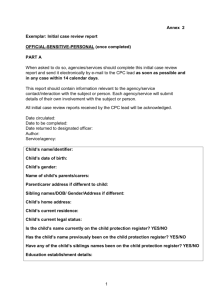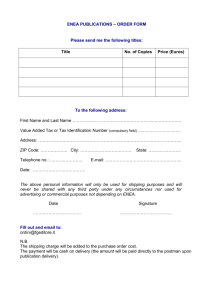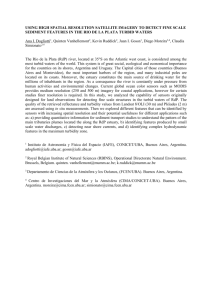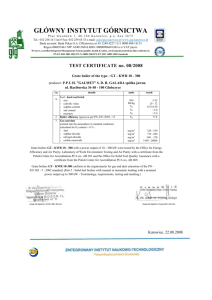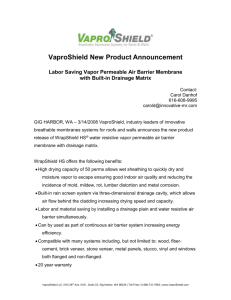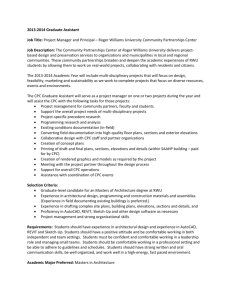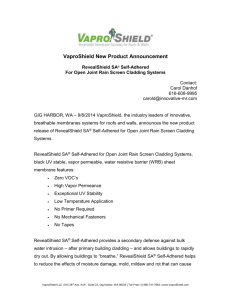SMES NEEDS - Act Clean
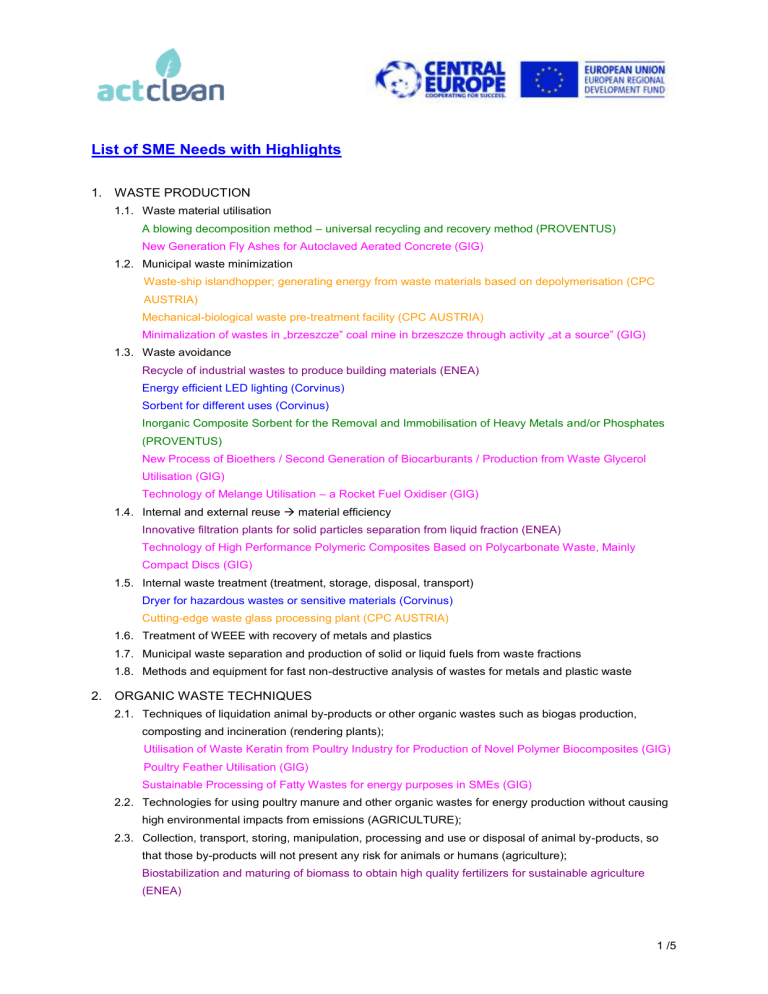
List of SME Needs with Highlights
1. WASTE PRODUCTION
1.1. Waste material utilisation
A blowing decomposition method
– universal recycling and recovery method (PROVENTUS)
New Generation Fly Ashes for Autoclaved Aerated Concrete (GIG)
1.2. Municipal waste minimization
Waste-ship islandhopper; generating energy from waste materials based on depolymerisation (CPC
AUSTRIA)
Mechanical-biological waste pre-treatment facility (CPC AUSTRIA)
Minimalization of wastes in „brzeszcze” coal mine in brzeszcze through activity „at a source” (GIG)
1.3. Waste avoidance
Recycle of industrial wastes to produce building materials (ENEA)
Energy efficient LED lighting (Corvinus)
Sorbent for different uses (Corvinus)
Inorganic Composite Sorbent for the Removal and Immobilisation of Heavy Metals and/or Phosphates
(PROVENTUS)
New Process of Bioethers / Second Generation of Biocarburants / Production from Waste Glycerol
Utilisation (GIG)
Technology of Melange Utilisation – a Rocket Fuel Oxidiser (GIG)
1.4. Internal and external reuse
material efficiency
Innovative filtration plants for solid particles separation from liquid fraction (ENEA)
Technology of High Performance Polymeric Composites Based on Polycarbonate Waste, Mainly
Compact Discs (GIG)
1.5. Internal waste treatment (treatment, storage, disposal, transport)
Dryer for hazardous wastes or sensitive materials (Corvinus)
Cutting-edge waste glass processing plant (CPC AUSTRIA)
1.6. Treatment of WEEE with recovery of metals and plastics
1.7. Municipal waste separation and production of solid or liquid fuels from waste fractions
1.8. Methods and equipment for fast non-destructive analysis of wastes for metals and plastic waste
2. ORGANIC WASTE TECHNIQUES
2.1. Techniques of liquidation animal by-products or other organic wastes such as biogas production, composting and incineration (rendering plants);
Utilisation of Waste Keratin from Poultry Industry for Production of Novel Polymer Biocomposites (GIG)
Poultry Feather Utilisation (GIG)
Sustainable Processing of Fatty Wastes for energy purposes in SMEs (GIG)
2.2. Technologies for using poultry manure and other organic wastes for energy production without causing high environmental impacts from emissions (AGRICULTURE);
2.3. Collection, transport, storing, manipulation, processing and use or disposal of animal by-products, so that those by-products will not present any risk for animals or humans (agriculture);
Biostabilization and maturing of biomass to obtain high quality fertilizers for sustainable agriculture
(ENEA)
1 /5
2.4. Animal welfare, adjustment of stabling, emissions of ammonia (agriculture);
2.5. Technologies for nitrogen abatement in zootechnical wastewaters (liquid and solid manure) also on a multi firms scale and on consortium scale, by transferring N to other farms located in other regions
(AGRICULTURE);
2.6. Treatments of paper and wood related materials
In situ bioremediation of paper sludge revovered for environmental /agriculture purposes (ENEA)
2.7. Recovery of agrofood production residues
Recovery and valorisation of cheese whey (ENEA)
Production of biofuels from lignocellulose waste generated in agriculture and the processing industry
(Corvinus)
Production of bio-diesel from waste cooking oil (CPC AUSTRIA)
3. CONSUMPTION OF ENERGY
3.1. Outdated energy production and distribution equipment
Energy efficient LED lighting (Corvinus)
Production of alternative fuels; converting worthless rubbish into a valuable energy source (CPC
AUSTRIA)
Fully automatic biomass heating system (pellets) (CPC AUSTRIA)
3.2. The reduction of heat loss
Energy-efficient reconditioning of sheet steel barrels and use of solvent-free lacquers (UBA)
Energy-efficient induction heating, using superconductors (UBA)
Regenerative unit ventilators for cooling of server rooms/ data centres (Proventus)
Gasholders, covers and lagoons for large gas-quantities storage. (CPC AUSTRIA)
3.3. Use of efficient solar heat collectors
Solar lamp “Double Sol”, solar path lights “Kion 2” and “Kion 3” for public lightening (CPC AUSTRIA)
3.4. Heat storage
3.5. EuP needs: new technologies to improve the energetic performances of materials (WOOD
FURNITURE, BUILDINGS).
EEMS, Elevator Efficiency Metering System (CPC AUSTRIA)
3.6. Low level of waste energy utilisation (e.g. heat exchangers)
3.7. Energy-efficient construction (new buildings)
Environmentally friendly compatible wine cooling (CPC AUSTRIA)
3.8. Energy-efficient reconstruction (renewal of existing buildings)
3.9. Use of renewable energy sources (solar, biomass, photovoltaic, etc.)
Adsorption chiller ACS 08/15 for solar and thermal cooling of buildings (UBA)
R718-Chiller (compression principle) for cooling and air conditioning (UBA)
Air-conditioning and transport cooling system using carbon dioxide (UBA)
Highly efficient vacuum tube collectors made of soda-lime glass with anti-reflection coating (UBA)
Solar heating by means of a heat pump for energy-saving houses (UBA)
Accurate wind energy forecasts (UBA)
Solar architecture / sustainable architecture / green architecture (GIG)
Automatic boiler for combustion of solid fuels (PROVENTUS)
Heat and electric power generator for bioethanol production based on renewable energy
(PROVENTUS)
Pellet Heating Boiler LESTER 20 (GIG)
2 /5
Production of biofuels from lignocellulose waste generated in agriculture and the processing industry
(Corvinus)
Integrated heating container including biomass-heating and solar collector (CPC Austria)
Wood pellet-fired c ombined heating and power generation facility, ‘Stirling Power Module’ (CPC
AUSTRIA)
3.10. Reuse of (industrial) waste heat
3.11. Remote electricity supply by PV cells including electricity storage, e.g. by hydrogen production and electricity production by fuel cells
4. AIR EMISSION
Dryer for hazardous wastes or sensitive materials (Corvinus)
4.1. Reduction of VOC emissions
VACUC-Lean-PLUS-method for degreasing of large work pieces (UBA)
Catalytic VOC (Volatile Organic Compounds) treatment solutions (PROVENTUS)
4.1.1. Using organic solvents without VOCs (surface treatment);
4.1.2. Technologies for reducing VOC emissions from formaldehyde (WOOD FURNITURE);
4.1.3. Availability of adhesives/glues with lower emissions of VOC (WOOD FURNITURE);
Facility for lacquer coating of wooden surfaces (reduction of lacquer consumption and VOC)(UBA)
MDF UV-powder coating in the office furniture industry (UBA)
4.1.4. Concentrating the VOC in waste streams ahead of incineration
4.1.5. Removal of VOC from waste air and recovery of organic compounds
4.2. Combustion of waste – emission limits (rendering plants);
4.3. Reduction of air emissions
– heavy metals, CO
Bioelectrical gas cleaner “BEGA” (UBA)
Processing & Utilisation of Sewage Sludge and Proteinaceous Off al Polluted with Chromium / Heavy
Metals (GIG)
Technology for Processing Zinc-bearing Waste with Installation for Flue Gas Desulphurisation (GIG)
Elimination of solvents emission (xylene, ethylglycol acetate) from the insulated conductors production process (GIG)
Minimization of dust emission to atmosfere creating during the process of melt in arc furnace (GIG)
4.4. Pollutant gas monitoring
Wireless chemical sensor network for pollutant and hazardous distributed gas monitoring (ENEA)
5. DISCHARGE OF WASTE WATER
5.1. Access to clean water, potential problems with water treatment facilities
Compact biological treatment of Waste-water from private households (CPC AUSTRIA)
5.2. Appropriate waste water management and sewage water treatment facilities
Best available technique for water reuse in textile SMEs (ENEA)
Starch based anionic and cationic flocculants (Corvinus)
Concrete waste-water hopper with special environment-friendly polypropylene bottom layer (CPC
AUSTRIA)
5.3. Technologies for purification of drinking water contaminated with nitrates and pesticides
5.4. Alternative waste water treatment after closedown of sewers due to demographic changes or migration
5.5. Consumption of water
Environmental-friendly coating process on aluminium coil (UBA)
3 /5
Water recirculation plants for aquaculture (UBA)
Closing the cooling water of manufacturing aggregates (GIG)
5.6. Water quality analysis
Compact and advanced laser spectrometer for water quality analysis (ENEA)
6. MEMBRANE SEPARATION TECHNIQUES FOR:
6.1. Removal of contaminants and recycling of water
6.2. Biological waste water treatment
Environmental-friendly membrane filtration technologies including microfiiltration, ultrafiltration, nanofiltration, reverse osmosis (CPC AUSTRIA)
6.3. Purification of water
7. TRANSPORT
7.1. Logistic improvement
7.2. Reliable and fast transportation: outdated vehicles
7.3. Availability of freight transport by train
8. PACKAGING AND CONSERVATION
8.1. Technologies for packaging and conservation: packaging reduction and optimisation (also from a
“sensorial” and “easy to use” point of view), product shelf life improvement, technologies for conservation processes. Higher diffusion of biodegradable packaging, nanotechnologies applications, intelligent packaging (time-temperature indicators, ..), active packaging (bioactive films, scavenger polymers, …) (AGRO FOOD).
9. EMISSION OF NOISE
Decreasing of noise emission and decreasing of electric energy consumption from near shaft equipment
(GIG)
10. ANIMAL BASED PRODUCTS
10.1. Hygienic rules for animal-based food related to SME food producers (agriculture);
10.2. Prevention, control and eradication of certain transmissible spongiform encephalopathies (TSE). It relates to production and placing live animals and animal products on the market, and in some specific cases their export (agriculture).
11. REVITALISATION PROCEDURES
11.1. Eco-effective technologies available for remediation of the site and then for a different new land development (industrial and service functions, housing, tourism and recreation, leaving for nature) with taking into account reduction of negative impact on environment of new function of the site,
Inorganic Composite Sorbent for the Removal and Immobilisation of Heavy Metals and/or Phosphates
(PROVENTUS)
Solar architecture / sustainable architecture / green architecture (GIG)
12. MELTING PROCESSES
12.1. Purity of raw material for melting process (non-ferrous foundry).
13. DEVELOPMENT OR REPLACEMENT OF EXISTING TECHNOLOGY
13.1. Ou tdated process equipment in SME’s in the chemical sector
14. USING AND STORING FERTILIZERS (AGRICULTURE)
4 /5
15. MANAGEMENT OF END OF LIFE
15.1. Solutions for the management of end of life of products and wood waste (WOOD FURNITURE);
16. SURFACE TREATMENT
Facility for lacquer coating of wooden surfaces (reduction of lacquer consumption and VOC)(UBA)
Environmental-friendly coating process on aluminium coil (UBA)
MDF UV-powder coating in the office furniture industry (UBA)
Dry-cleaning of engine parts using electromagnetic vibrations (UBA)
Clean surfaces using laser techniques (UBA)
Device for Purifying Emulsion Cutting Fluids UPE-10 (GIG)
16.1.
Anticorrosive treatment of hot metallic surfaces (up to 600°C) by pasivation and special paints
16.2. Diluent paints and protective coatings and water dispersion coatings for special uses
16.3. Shift from chromium VI to chrome IV and III (chromium IV ban)
16.4. Reduction or avoidance of VOC emissions
Nitrothermspray painting (ENEA)
16.5. Reduction of waste - lacquer sludge (to avoid disposal)
- waste water (to avoid treatment)
16.6. Material efficiency (material cost reduction)
16.7. Inefficient surface treatment solutions
16.8. Energy efficiency
17. REFRIGERATION AND SOLAR COOLING
17.1. Raising attractiveness of installing devices with natural refrigerants – with regards to certain fluorinated gases,
17.2. Phase-out of the HCFC refrigerant R22
17.3. Efficient cooling technologies
17.4. Energy efficiency
Solar office-cooling facility (CPC Austria)
18. GREEN PRODUCTS
Insulating and Hygienic Telescoping Aluminium Ladder (ENEA)
FSC papers for printing houses (Corvinus)
A New Generation of Food Grade Lubricants (GIG)
19. ANALYTICAL TOOLS-LABORATORY EQUIPMENT
PMT Electronic Device for low optical noise detection (ENEA)
Isotope & Tracer Methods for Water Relations Determination in Surroundings of Open Coal Mines /
Industrial Areas (GIG)
Identification System of Air Pollution Inflow (SINZaP) (GIG)
Mobile Control Laboratory (MCL) (GIG)
Automatic Station for Detection of Petroleum-Originated Pollution in Water (GIG)
5 /5
